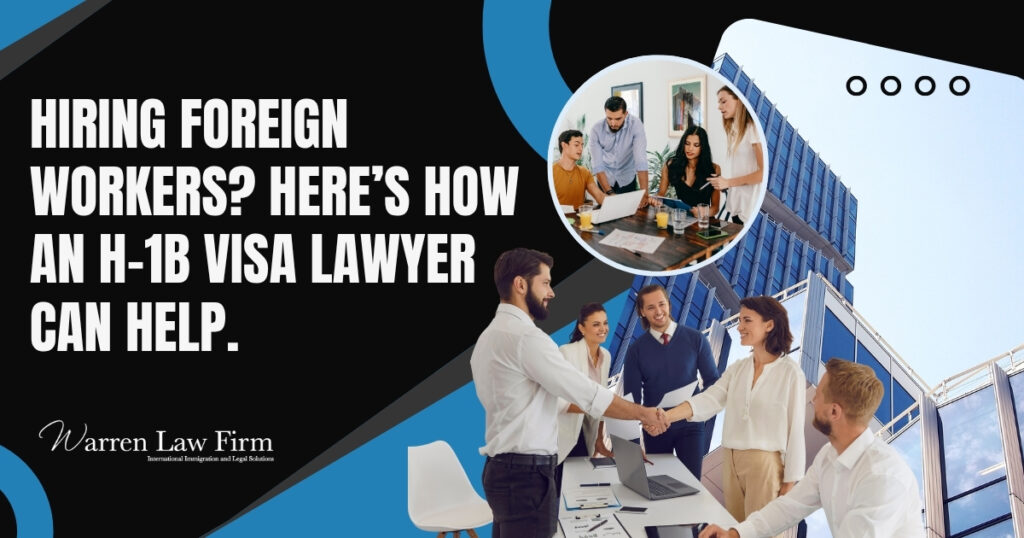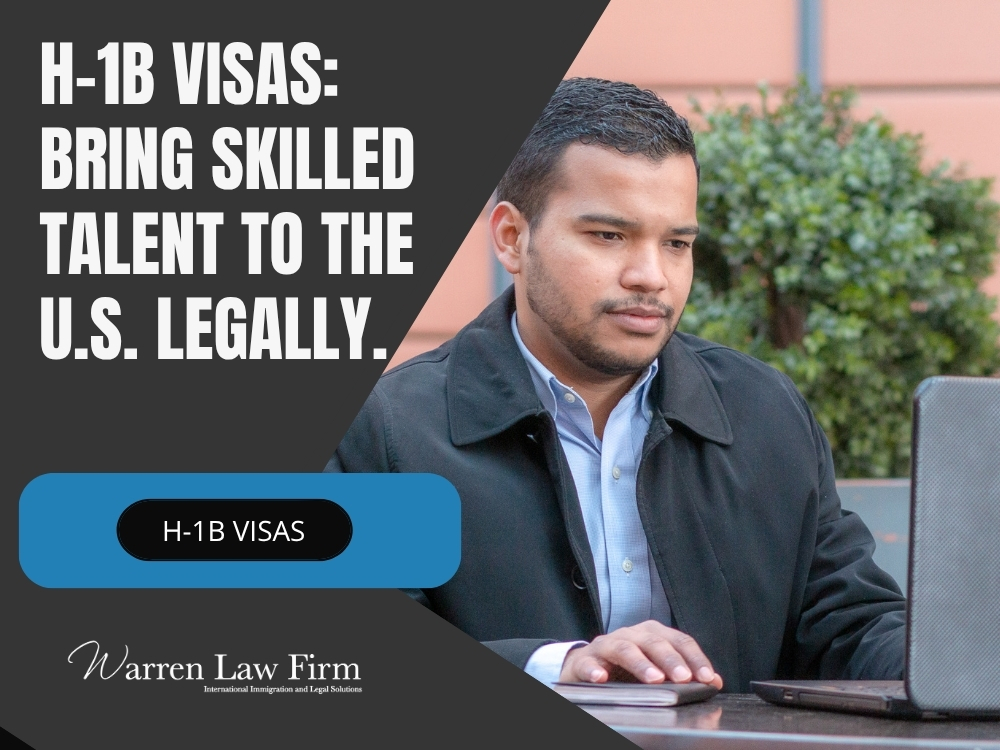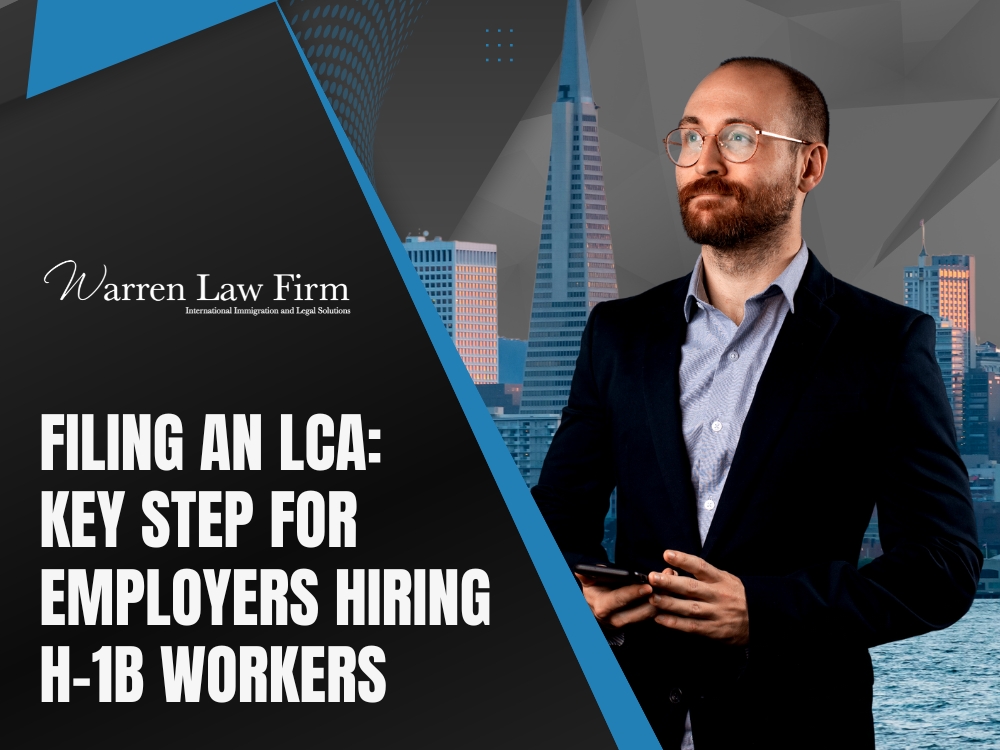H-1B Lawyer
Home » Work Visas and Employment Green Cards » H-1B Lawyer | Warren Law Firm

If you’re interested in hiring a foreign worker, you may be able to bring them to the United States on an H-1B visa with the help of an H-1B lawyer. This guide explains H-1B visas so you can make the right choices for your workforce.
Table of Contents
Request A Consultation
Meet The Attorney
Angela D. Warren
With more than 20 years of immigration and business immigration experience, Angela Warren has helped hundreds of individuals, families and businesses.
Get The Immigration Help You Deserve
What is an H-1B Visa?
The H-1B visa is a non-immigrant work visa that allows U.S. employers to temporarily employ foreign workers in specialty occupations. A specialty occupation is one that requires the theoretical and practical application of a body of highly specialized knowledge, and a bachelor’s degree or higher in the specific specialty (or its equivalent) is normally the minimum requirement for entry into the occupation.
What Are H-1B Specialty Occupations?
Some examples of occupations that qualify as specialty occupations include:
- Accountants
- Architects

- Engineers
- Financial analysts
- Graphic designers
- Market research analysts
- Medical doctors and surgeons
- Scientific researchers
Do You Need An H-1B Lawyer?
An H-1B lawyer assists employers and employees in understanding the H-1B legal requirements, preparing the necessary documentation, and ensuring compliance with U.S. immigration laws. An experienced H-1B lawyer can help identify potential issues in your case, suggest strategies to strengthen your petition and provide support throughout the process. They can also keep you updated on changes to immigration policies and regulations that might impact your case.
Without the expertise of a skilled lawyer, applicants may face delays, rejections, or even legal complications that could have been avoided. By hiring a knowledgeable H-1B attorney, you’re investing in a smoother, more efficient path to achieving your immigration goals.
What Are H-1B DOD Researcher and Development Project Workers?
The Department of Defense (DOD) has a separate H-1B category for workers who are engaged in basic research, applied research, or advanced development projects in a DOD intramural or extramural research program. This category is limited to 26,000 visas per year.
Who Qualifies as an H-1B Fashion Model?
To qualify for an H-1B3 visa, the applicant must demonstrate that they are a fashion model of distinguished merit and ability and that their employment will substantially assist in achieving recognition of the United States as a center of excellence for modeling.
Can You File for Your Own H-1B Visa?
You cannot file for your own H-1B visa. Your employer must file a petition on your behalf with the U.S. Citizenship and Immigration Services (USCIS).
Get The Immigration Help You Deserve
What is a Labor Condition Application?
A Labor Condition Application (LCA) is a document that an employer files with the Department of Labor (DOL) to establish that the wages and working conditions of H-1B workers will not adversely affect the wages and working conditions of U.S. workers.
How Does an Employer Get an LCA?
The employer must first obtain an LCA from the DOL. The employer then files the LCA with USCIS as part of the H-1B petition process.

Often, people choose to work with an H-1B immigration lawyer to get an LCA. There’s a lot of paperwork involved, and there are many steps to the process. Typically, the employer must have a valid LCA before hiring a worker and before the worker can come to the United States.
First, an immigration attorney helps the employer fill out ETA 9035. Then, the H-1B lawyer files it with the Department of Labor. The Department of Labor will look at the wage rate and make sure it’s high enough. They’ll also check to see if any U.S. workers can do the job.
If everything looks good, the Department of Labor will approve the LCA and send it back to the immigration attorney. The lawyer will then file it with USCIS as part of the H-1B petition process.
Get The Immigration Help You Deserve
How Can An Employer File an H-1B Visa for a Worker?
To file for an H-1B visa for a worker, the employer should follow these steps:
- The employer should have a valid LCA from the Department of Labor. Without an LCA, the application may not go any further. (See the earlier section, “How Does an Employer Get an LCA?” for more information.)
- The employer should file a petition on the worker’s behalf with USCIS, using Form I-129. The employer should include the approved LCA with the petition.
- The prospective worker applies for a visa for admission to the United States.
- After the petition is approved, the worker can come to the United States and start working in their specialty occupation.
Here’s a closer look at each.
Step 1: The Employer Files for an LCA
The first step is for the employer to file an LCA with the Department of Labor. The employer can do this with the help of an immigration attorney.
As part of the LCA process, the employer must attest to the following:
- The wage that they will pay the H-1B worker is high enough. It must be at least the prevailing wage for the occupation in the area of employment.
- There is no strike or lockout at the place of employment.
- Working conditions will not adversely affect other workers at the employer’s company.
- The employer will give notice to union representatives (if there is a union) or to workers (if there is no union) about the hiring of H-1B workers.
- The employer will maintain a public access file with certain information about the H-1B workers, including the LCA.
- The employer has not displaced any U.S. workers in the past 90 days and will not do so in the next 90 days.
- The employer has not laid off any U.S. workers in the past 90 days and will not do so in the next 90 days.
- The employer has not moved the workplace of any U.S. workers in the past 90 days and will not do so in the next 90 days.
After the employer files the LCA, the Department of Labor will review it to make sure that the employer has met all of the requirements. If everything looks good, the DOL will approve the LCA and send it back to the employer (usually within 7-14 days). The employer will then need to keep the approved LCA in their public access file.
Step 2: The Employer Files Form I-129
Once the employer has an approved LCA, they can move on to the next step: filing Form I-129 with USCIS. This is the petition that the employer will use to request an H-1B visa for the worker. Usually, employers work closely with an H-1B immigration lawyer to do this.
The employer will need to include the following with their I-129 petition:
- The approved LCA from Step 1.
- A copy of the worker’s diploma or degree (if they have one).
- Documentation showing that the worker has the experience and credentials necessary for the job they’re applying for. This might include things like transcripts, letters from previous employers, licenses, etc.
- A job offer letter from the employer to the worker. This should state the salary that the worker will be paid, as well as the duties they will be expected to perform.
- Proof that the employer has enough money to pay the worker’s salary. This might include tax documents, financial statements, and similar documentation.
- Documentation showing that the employer has made an effort to recruit U.S. workers for the position (if required). This might include ads placed in newspapers or online, job fairs attended, and a variety of other types of proof.
After the employer has gathered all of the necessary documentation, they can submit the petition to USCIS. USCIS will then review the petition to make sure that everything is in order. If it is, they will approve the petition and send it back to the employer.
Step 3: The Worker Applies for a Visa or Admission
After the employer has received approval from USCIS, the next step is for the worker to apply for a visa for admission to the United States. The worker can do this by going to a U.S. consulate or embassy in their home country and applying for a visa.
In order to get a visa, the worker will need to show the following:
- That they have an approved H-1B petition from their employer.
- That they have a valid passport.
- That they have proof of ties to their home country (such as a property, family, etc.). This is to show that they don’t intend to immigrate to the United States permanently.
- That they have enough money to support themselves while in the United States.
- That they are in good health and have had all required vaccinations.
- That they are not inadmissible to the United States for any reason (such as having a criminal record).
If the worker is already in the United States, they can apply for a change of status to H-1B status. In order to do this, they will need to file Form I-129 along with the required documentation. USCIS will then review the petition and, if everything is in order, they will approve the change of status.
After the worker has been approved for an H-1B visa or change of status, they can start working for their employer in the United States. The H-1B visa is valid for up to three years, and it can be renewed once for an additional three years. After that, the worker will need to return to their home country for at least one year before they can apply for another H-1B visa.
Get The Immigration Help You Deserve
H-1B Lawyer FAQ
Can I switch employers while on an H-1B visa?
Yes, H-1B visa holders can switch employers, but the new employer must file a petition to transfer the H-1B visa. This process must be completed and approved by USCIS before starting work with the new employer.
Are family members allowed to accompany H-1B visa holders?
Spouses and children under 21 years old can accompany H-1B visa holders under the H-4 visa category. However, H-4 visa holders may have limited work authorization, depending on specific conditions.
How does the H-1B lottery work?
Due to high demand, the H-1B visa is subject to an annual cap. Each year, a random lottery is conducted to select eligible applicants. Currently, there is a cap of 65,000 visas, with an additional 20,000 available for individuals holding advanced degrees from U.S. institutions.
Can I adjust my status from an H-1B visa to green card?
Yes, it is possible to adjust your status from an H-1B visa to a green card. This process typically involves employer sponsorship through an employment-based green card category, such as EB-2 or EB-3. The adjustment of status process usually begins with the employer filing a PERM labor certification (if required) and submitting an I-140 Immigrant Petition for Alien Worker.
Once the I-140 is approved and a visa number is available, you can file an I-485 Application to Register Permanent Residence or Adjust Status. It’s crucial to work closely with experienced immigration professionals to ensure compliance with all legal requirements and timelines during this transition.
Alternatively, if you get married to a U.S. citizen or lawful permanent resident, you may be eligible for a marriage-based green card. This process involves filing an I-130 Petition for Alien Relative and submitting an I-485 Application to Register Permanent Residence or Adjust Status.
Do You Need to Talk to an H-1B Immigration Lawyer?
If you need to talk to an immigration attorney about getting an H-1B visa for a worker, we’re here to help. Call our office today to schedule a consultation; we can answer your questions about everything from LCAs to the visa process.
